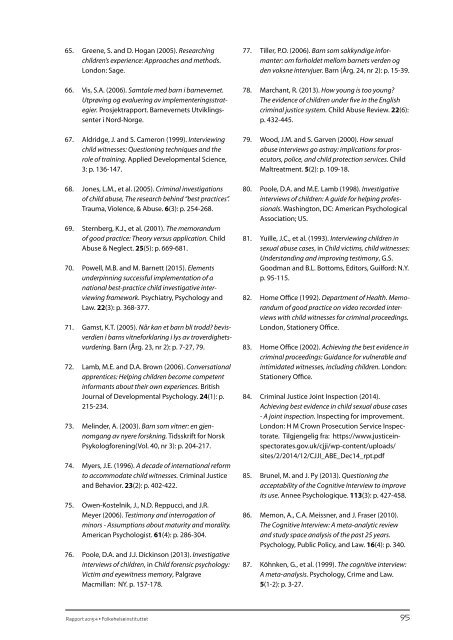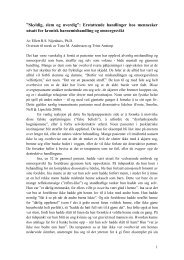rapport 2015:4
641aa6d88d
641aa6d88d
Create successful ePaper yourself
Turn your PDF publications into a flip-book with our unique Google optimized e-Paper software.
65. Greene, S. and D. Hogan (2005). Researching<br />
children’s experience: Approaches and methods.<br />
London: Sage.<br />
66. Vis, S.A. (2006). Samtale med barn i barnevernet.<br />
Utprøving og evaluering av implementeringsstrategier.<br />
Prosjekt<strong>rapport</strong>. Barnevernets Utviklingssenter<br />
i Nord-Norge.<br />
67. Aldridge, J. and S. Cameron (1999). Interviewing<br />
child witnesses: Questioning techniques and the<br />
role of training. Applied Developmental Science,<br />
3: p. 136-147.<br />
68. Jones, L.M., et al. (2005). Criminal investigations<br />
of child abuse, The research behind “best practices”.<br />
Trauma, Violence, & Abuse. 6(3): p. 254-268.<br />
69. Sternberg, K.J., et al. (2001). The memorandum<br />
of good practice: Theory versus application. Child<br />
Abuse & Neglect. 25(5): p. 669-681.<br />
70. Powell, M.B. and M. Barnett (<strong>2015</strong>). Elements<br />
underpinning successful implementation of a<br />
national best-practice child investigative interviewing<br />
framework. Psychiatry, Psychology and<br />
Law. 22(3): p. 368-377.<br />
71. Gamst, K.T. (2005). Når kan et barn bli trodd? bevisverdien<br />
i barns vitneforklaring i lys av troverdighetsvurdering.<br />
Barn (Årg. 23, nr 2): p. 7-27, 79.<br />
72. Lamb, M.E. and D.A. Brown (2006). Conversational<br />
apprentices: Helping children become competent<br />
informants about their own experiences. British<br />
Journal of Developmental Psychology. 24(1): p.<br />
215-234.<br />
73. Melinder, A. (2003). Barn som vitner: en gjennomgang<br />
av nyere forskning. Tidsskrift for Norsk<br />
Psykologforening(Vol. 40, nr 3): p. 204-217.<br />
74. Myers, J.E. (1996). A decade of international reform<br />
to accommodate child witnesses. Criminal Justice<br />
and Behavior. 23(2): p. 402-422.<br />
75. Owen-Kostelnik, J., N.D. Reppucci, and J.R.<br />
Meyer (2006). Testimony and interrogation of<br />
minors - Assumptions about maturity and morality.<br />
American Psychologist. 61(4): p. 286-304.<br />
76. Poole, D.A. and J.J. Dickinson (2013). Investigative<br />
interviews of children, in Child forensic psychology:<br />
Victim and eyewitness memory, Palgrave<br />
Macmillan: NY. p. 157-178.<br />
77. Tiller, P.O. (2006). Barn som sakkyndige informanter:<br />
om forholdet mellom barnets verden og<br />
den voksne intervjuer. Barn (Årg. 24, nr 2): p. 15-39.<br />
78. Marchant, R. (2013). How young is too young?<br />
The evidence of children under five in the English<br />
criminal justice system. Child Abuse Review. 22(6):<br />
p. 432-445.<br />
79. Wood, J.M. and S. Garven (2000). How sexual<br />
abuse interviews go astray: implications for prosecutors,<br />
police, and child protection services. Child<br />
Maltreatment. 5(2): p. 109-18.<br />
80. Poole, D.A. and M.E. Lamb (1998). Investigative<br />
interviews of children: A guide for helping professionals.<br />
Washington, DC: American Psychological<br />
Association; US.<br />
81. Yuille, J.C., et al. (1993). Interviewing children in<br />
sexual abuse cases, in Child victims, child witnesses:<br />
Understanding and improving testimony, G.S.<br />
Goodman and B.L. Bottoms, Editors, Guilford: N.Y.<br />
p. 95-115.<br />
82. Home Office (1992). Department of Health. Memorandum<br />
of good practice on video recorded interviews<br />
with child witnesses for criminal proceedings.<br />
London, Stationery Office.<br />
83. Home Office (2002). Achieving the best evidence in<br />
criminal proceedings: Guidance for vulnerable and<br />
intimidated witnesses, including children. London:<br />
Stationery Office.<br />
84. Criminal Justice Joint Inspection (2014).<br />
Achieving best evidence in child sexual abuse cases<br />
- A joint inspection. Inspecting for improvement.<br />
London: H M Crown Prosecution Service Inspectorate.<br />
Tilgjengelig fra: https://www.justiceinspectorates.gov.uk/cjji/wp-content/uploads/<br />
sites/2/2014/12/CJJI_ABE_Dec14_rpt.pdf<br />
85. Brunel, M. and J. Py (2013). Questioning the<br />
acceptability of the Cognitive Interview to improve<br />
its use. Annee Psychologique. 113(3): p. 427-458.<br />
86. Memon, A., C.A. Meissner, and J. Fraser (2010).<br />
The Cognitive Interview: A meta-analytic review<br />
and study space analysis of the past 25 years.<br />
Psychology, Public Policy, and Law. 16(4): p. 340.<br />
87. Köhnken, G., et al. (1999). The cognitive interview:<br />
A meta-analysis. Psychology, Crime and Law.<br />
5(1-2): p. 3-27.<br />
Rapport <strong>2015</strong>:4 • Folkehelseinstituttet 95



